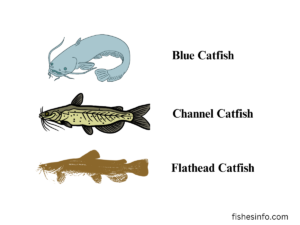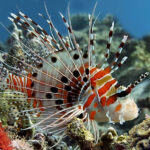What is Catfish?
As long as 10 feet double the height of a common layman! Catfish is a well-known and widespread fish for eating found all over the world. It has almost 3000 species belonging to the order Siluriformes making it one of the largest groups of freshwater fishes. They live in freshwater and saltwater.
These fish are known for their adaptability to various habitats, including rivers, lakes, and ponds, and are known as the bottom feeders of soil, scavenging insects, crustaceans, and various plants.
Scientific Classification
| Kingdom | Animalia |
| Phylum | Chordata |
| Class | Actinopterygii |
| Order | Siluriformes |
| Families | 35 |
| Species | 3000 |
Common Species
Channel Catfish (Ictalurus punctatus)
Channel Catfish are a popular catfishing species and also for aquaculture. These are only 1-2 feet long and found in the rivers of North America.
Blue Catfish (Ictalurus furcatus)
Blue catfish is the second most common species of this group native to large lakes and reservoirs in Mississippi. They are 5 feet in length with a blue-grey color. These are the largest catfish found in North America.
Flathead Catfish (Pylodictis olivaris)
Flathead catfish are the habitants of USA rivers (slow-rivers) and can grow up to the size of 4-5 feet long. They are yellow-brown and are among the top freshwater predators.

Mekong Giant Catfish (Pangasianodon gigas)
They are found mostly in Southeast Asia regions of the world in the Mekong River. These giant fishes are the largest among the species up to 10 feet long. The catfish is pale in appearance with no barbels. Now become an endangered species.
Pictus Catfish (Pimelodus pictus)
Pictus is native to the Amazon or Orinoco rivers. They are about 4-5 inches in size with silver bodies and black spots on the skin. They are considered the popular species in aquarium hobbyists.
Appearance of Catfish
| Body Shape | Elongated to thick or slender bodies differ from species to species.Smooth skin with no scales on the body |
| Barbels | Whisker barbels around the mouth that help to smell food |
| Body Structure (Head, Mouth) | Flat broad head with a wide mouth |
| Skin Colors and Patterns | gray, brown, black, yellow, or albino skin colors with spotted or striped patterns on the skin |
| Size | 4 Inch to as long as 10 feet |
Areas Of World Catfish Are Found?
Most commonly these fishes can be found in rivers, reservoirs, or ponds in the USA, Canada, and Asia.
Rivers & Streams
- Mississippi River (USA)
- Amazon River (South America)
- Nile River (Africa)
- Mekong River (Asia)
Lakes & Reservoirs
- Great Lakes (USA & Canada)
- Lake Victoria (Africa)
- Lake Baikal (Russia)
Ponds & Swamps
- Swamps of the Southeastern USA
- Wetlands in Southeast Asia
Coastal & Estuarine Waters
Ariid catfish are found in brackish waters and coastal regions.
Nutritional Value (Per 100g Cooked)
Catfish is a famous seafood with the least saturated fats and the highest protein-packed white meat. It is the best option for diet freaks. Following is the table discussing all nutrients and the amounts the catfish contains.
| Calories | 105 kcal |
| Proteins | 18g |
| Fats | 2.9g |
| Saturated Fats | 0.8g |
| Monounsaturated Fat | 1.3g |
| Polyunsaturated Fat | 0.5g |
| Omega-3 Fatty Acids | 200–300 mg |
| Omega-6 Fatty Acids | 400–600 mg |
| Cholesterol | 58mg |
| Carb | 0g |
| Fiber | 0g |
| Vit B12 | 2.3 mcg |
| VIT D | 500 IU |
| Calcium | 10mg |
| Iron | 0.5mg |
| Sodium | 50 mg |
| Magnesium | 20 mg |
| Selenium | 14 mcg |
Importance of Catfish
Catfish are significantly known for their use in the food industry as well as aquaculture. These fish have both ecological and traditional importance in cuisines. Catfish are popular in Southern U.S. cuisine and are mostly served as fried seafood or cooked in sauce. They are mild in flavor and texture.
Additionally, catfish farming has become a vital industry, with species like channel catfish being raised for consumption due to their fast growth rates and efficient feed conversion. Overall, catfish hold both ecological and economic significance, contributing to biodiversity and food security worldwide.
Health Benefits
Adding catfish to the diet can provide several health and skin benefits:
Lean Protein Source: 100g of catfish can provide 18g of lean protein to your body which helps fulfill body protein demand. Essential for muscle mass and tissue repair.
Vitamin B12: Similarly a 100g of catfish is rich in VitB12 delivering up to 121% of daily value for Vit B12 that supports the red blood cell formation and regulation in the human body.
Heart Health: Catfish is full of omega-3 fatty acids which are known to reduce inflammation, support cardiovascular health, and regulation of heart activity.
Low Calories: Catfish is low in calories and comprises healthy fat, vitamins, and minerals which is why it is a complete meal for those who are on a diet and weight gain conscious.
Potential Side Effects
While catfish is generally safe to eat, but contains potential substances that could be harmful for some potential people. One must know the following potential side effects of catfish.
Contaminants: Depending on their ecological system and variant habitats, catfish can accumulate harmful chemicals like mercury and PCBs, which may pose health risks for humans.
Allergic Reactions: Some individuals may experience allergies to catfish, leading to symptoms such as hives, swelling, or breathlessness.
Pricing in the U.S
The price of catfish in the United States varies from $4.00 to $5.50 depending on the sources whether wild-caught or farm-raised, processing, and regional demand.
Popular Catfish Recipes
Catfish’s mild flavor and firm texture make it a versatile ingredient in various dishes. Incorporating catfish into your daily meals can be both a delicious and nutritious choice by cooking the fish in different styles for your family as with any seafood. Here are some popular preparations.
| Crispy Oven-Fried Catfish Nuggets | Marinate catfish pieces in seasoned buttermilk, coat with a spiced cornmeal mixture and bake or fry until golden brown. |
| Grilled Catfish Tacos | Season fillets with cumin and chili powder, grill until flaky, and serve in tortillas with slaw and salsa. |
| Catfish Stew | Simmer catfish with onions, bell peppers, celery, and tomatoes, seasoned with Creole spices, and serve over rice. |
| Blackened Catfish | Rub fish fillets with a blend of spices like paprika, cayenne pepper, olive oil dressing, and thyme, then sear in a hot skillet until dark-crusted. |
| Catfish Po’Boy Sandwich | Fry catfish fillets until crispy, then serve on a French roll with lettuce, tomatoes, pickles, and remoulade sauce. |
Pan-Fried Catfish
Ingredients:
- 4 catfish fillets
- 1 cup cornmeal
- 1/2 cup all-purpose flour
- 1 teaspoon paprika
- 1/2 teaspoon salt
- 1/2 teaspoon black pepper
- 1/2 teaspoon cayenne pepper (optional, for heat)
- 1 cup buttermilk
- Oil for frying (vegetable or canola)
- Fresh lemon wedges (for serving)
Instructions:
- Prepare the Breading: In a shallow dish, mix the cornmeal, flour, paprika, salt, black pepper, and cayenne pepper.
- Dip each catfish fillet in buttermilk, allowing excess to drip off, then well-coated the cornmeal mixture.
- Fry the Fillets: Add the coated catfish fillets to the skillet, cooking for about 3-4 minutes on each side, until golden brown and crispy.
- Take out the fillets and remove the excess oil.
- Enjoy the serving.

Baked Catfish with Herbs and Lemon
Ingredients:
- 4 catfish fillets
- 2 tablespoons olive oil
- 1 lemon (zested and juiced)
- 2 cloves garlic, minced
- 1 teaspoon dried thyme (or 1 tablespoon fresh)
- 1 teaspoon dried oregano (or 1 tablespoon fresh)
- Salt and pepper to taste
- Fresh parsley, chopped (for garnish)
Instructions:
- Preheat your oven to 375°F (190°C).
- Prepare the mixture: In a bowl, mix olive oil, lemon juice, lemon zest, garlic, thyme, oregano, salt, and pepper.
- Marinate the Catfish fillets: Place the catfish fillets in a baking dish and pour the marinade over them. Let them marinate for about 20 to 30 minutes.
- Bake the Catfish: Bake in the preheated oven for 20-25 minutes or until the fish flakes easily with a fork.
- Garnish and Serve: Remove from the oven and Serve with rice or steamed vegetables.
Common Catfish Species Used In Fishing and Traditional Cuisine
- Channel Catfish (Ictalurus punctatus): It is the most common type of catfish found in the southern state of the U.S. And is known for its firm texture and mild flavor.
- Flathead Catfish (Pylodictis olivaris): These fish are often native to the wild and are less commonly farmed than channel catfish and are still sought after for their taste. They are popular in certain areas of the Midwest and South.
- Blue Catfish (Ictalurus furcatus): This species is also farmed, particularly in the United States. Blue catfish are known for their large size and tasty meat, making them a favorite among anglers and for commercial purposes.
- Asian Catfish (Pangasius spp.): The fish is mainly farmed in Southeast Asia, particularly in Vietnam, and is commonly found in international markets. It’s popular for its white, flaky flesh and is often sold as basa or swai between $4.0 to $6.0 more or less.
These are all the catfish varieties that are favored not only for their culinary qualities but also for their adaptability to aquaculture systems. They are widely available in tremendous amounts in seafood markets.
Frequently Asked Questions
How is U.S. Farm-Raised Catfish produced?
U.S. Farm-Raised Catfish in a controlled environment in clay-based ponds filled with fresh water from underground wells. They are given formulated human-made food of high-protein pellets that help them to grow faster and give more meat.
What is the typical size of a fully grown U.S. Farm-Raised Catfish?
Catfish are mostly farmed in the U.S. with a scientifically formulated diet typically weighs between 1 and 2 pounds.
What are the nutritional benefits of consuming U.S. Farm-Raised Catfish?
U.S. Farm-Raised Catfish is a lean fish and an excellent source of protein. It is low in saturated fat and is a good source of lean protein,omega-3 fatty acids, minerals, and vitamins.
What are the primary challenges faced by catfish farmers?
Catfish farmers need to follow some precautionary measures and encounter several challenges, including disease occurrence, water quality management, and food costs. Effective management practices and technological guidance are essential for the setup.
Conclusion
Catfish has nutritional and health benefits for seafood lovers. It is an important food source in the seafood industry and has a reasonable market price. The rapid growth and nutritional value of catfish make it one of the most common traditional cuisines in the U.S. market. They are a vital species for both aquaculture and fish markets.










